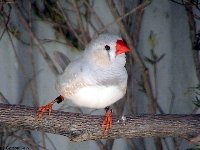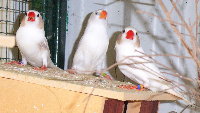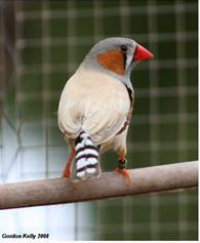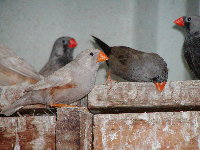


ZEBRA FINCH
Poephila guttata.
Alternate
Names:
Zebbie,
Brown Eared finch, Shelly.
Availability:
Zebra
finches must be the most freely available finch in Australia. They can be found
most anywhere.
Usually the best Zebra finches can be obtained from specialist breeders and
these may be found within most finch clubs in Australia.
However, for those just wishing to "get into" finches the garden varieties
available from the Pet store will serve just as well!
Sexing:
The sexing of the Zebra finch is easy
as they are dimorphic meaning the two sexes are
visually different to each other.
The male Zebra Finch has a tan patch on each cheek as well as tan along the flanks with white spots. Fine black bars cross the chest and white on the rump leading down to a white belly. The tail is barred black and white. The back is grey and the bill is red.
The hen is an overall grey with the banded tail. The abdomen is not as white as the male. The hen does not carry the tan cheek patches or the tan flanks. The bill is not as red as the male.
In white bird generally the hen's bill is an orange colour as against the cocks red bill.
Mutations:
There are
numerous mutations of the Zebra finch worldwide and we have a considerable
number here in Australia.
We have; Pied, Silver,
Fawn, Fawn Pied, Black Faced, Black Body, Black Fronted, Black Bodied Silver,
Isabel, Carabel, Charcoal, Fawn Charcoal, Slate, George, Cream, White, Marked
White, Red, Isabel.....and the list goes on.
The latest accepted
mutation by the Zebra Finch Federation of Australia is the Alumina.
 |
 |
 |
| Red Zebra. | Fawn Zebra. | Silver Zebra. |
Distribution:
The Zebra Finch prefers the more
arid areas of central Australia from east to west, but is also found in many of
the coastal regions.
They are not found in Tasmania
or the top of Cape York.
Compatibility:
They can be a real pain at times when
sharing an aviary with mixed finches. They will take over nests of smaller birds
and bully them around the feeding station.
They will steal nesting materials from other bird's nests and the young go on
visits and will hop in and out of any other inhabitants nest.
Their propensity to out breed most other finches also means that the have the
potential to take over even in the largest aviary!!
However, after saying all of that they are one of
the best birds to have around. Their incessant chattering and quaint call is
terrific to hear in anyone's backyard.
They are better housed with the bigger type of finch such as the Bengalese,
Chestnut, Cutthroat, Java and
Aberdeen.
For anyone considering introducing their children to the world of birds then
these guys are a must as they are virtually bomb-proof and most allow their
young to be handled.
Ease
of breeding (rating 1 to10):
As with the Bengalese if
you stand still too long in the aviary they will breed in your pockets!
So I'll give them the same rating as the humble Bengalese 14 out of 10.
Purchasing
your bird:
It is not hard to find Zebra finches
for sale - I think you'd be able to find them in a chemist shop!!
Thus saying we recommend that you purchase them from a breeder or a reputable
bird dealership in order to be sure of the quality of your stock.
For the show quality stock you would have to seek out a professional breeder of
show quality finches.
Good points to look for:
Look for a bird with clear bright eyes.
A bird that is moving and alert.
The feathers must be bright, tight and clean.
The feet, legs and mandible should be clean and
free from flaking.
The colours of the bird should be strong.
Faults to look for:
Skinny undersized and undernourished
birds are a problem when confronting buying your birds. This is especially true
of bird benched at bird sales where fear makes even the sickest bird look bright
to the untrained eye!!
The usual things such as a soiled vent, fluffed up appearance, weepy eyes,
bedraggled feathers are a sure sign of things that you don't want to see in your
newly acquired birds.
If it looks sick then it most probably is, so don't touch it.
 |
 |
 |
| Young Red Zebras. | Cock Red Zebra. | Cock Red Zebra. |
Aviary
or breeding cabinet:
The Zebra finches that
are aviary bred will settle down to a cabinet situation and the cabinet bred
birds know nothing else and are quiet happy in their environment and will
readily breed in cabinets, but it is in the aviary situation that they are at
their true best.
They are fine in small aviaries of a couple of meters to very large well-planted
aviaries.
Their suitability is such that they will be at home in the largest aviary or in
a budgie-type cage in the smallest flat - and chances are their breeding prowess
will not be diminished by the size of the cage!!
Breeding season:
Zebbies will readily breed all year
round without any problems. You should restrict your breeding birds to 3 or 4
nests before separating them so that the hen can have a rest from the rigours of
breeding and raising chicks. If you do intend on giving your hen a rest I would
suggest a rest of at least 2 to 3 months.
Off-season
feeding:
I am not fond of changing the diet
of the Zebbie, as they are such an active bird that they need a good diet to
keep their energy levels up.
I would suggest that you keep the birds on a good even diet in the off -season
(when the birds are separated) to build them up again for the rigors of the
upcoming breeding season.
Again the restriction of high protein softfoods and many other greenfood extras
during the winter months will/may discourage them from breeding.
Should
I feed soft foods?
Yes feed a soft food by all means as
these forever hungry little blighters will eat just about anything they can get
their little beaks into. Take a stock-take on your fingers when you leave the
aviary just in case!
What
green feed?
Zebra finches love just about nothing
more than fresh seeding grasses. It is an important part of their diet. I know
people who just feed their Zebbies only seed and I just feel for those poor
little birds. It is a very sad sight indeed.
Some of the greens I feed my Zebbies are Endive (daily), Bok choy, Guinea grass,
Summer and Winter grass, Shepherds purse, Milk thistle, Chickweed and Clover to
name a few.
As some people say "they're only just Zebra finches", well, they are as entitled
to a diet as rich a diet that you would provide for a pair of birds worth $3000.
As we say they are fantastic as a start on the road to rarer finches so if you
are not prepared to feed them properly you will learn nothing of value to assist
you husbandry - experiment and learn!
What
live food?
I have always fed a diet that
involves live food to my Zebra's. It has termites and maggots (gentles). I have
found better breeding results when any type of live food is added to their diet.
However, you may find that most Zebbies do not readily take to livefood.
Breeding season feeding:
When the weather starts
to warm after the chills of winter is usually the time to start your breeding
program.
This is when you start to slowly give your birds some extra bits in their
feed tray.
Let the birds build up to the extra live food such as termites, mealworms,
gentles and green seeding grasses.
Too much too soon can easily cause all types of problems including scours.
Some of the seeding grasses that may be used are, Johnston grass, African veldt
grass, chickweed, winter grass, any of the Ehrharta family, Guinea grass, Milk
thistle and Shepherds purse.
It is best to give stars the seeding heads half ripe.
Separating the pairs:
It is a good idea to separate the
pairs when they have had 3 or 4 nests in a row.
It is best to give them about a 2 to 3 month layoff before reintroducing them.
You can at this time change the partners over if you have a couple of pairs.
What
age do they breed?
Zebra finches will start
breeding at 3 months of age if you let them. It is advisable to allow them to
attain an age of at least 9 months if you want a good breeding life out of your
young birds.
Ignore this advice and you risk egg-binding in younger hens.
 |
 |
| A Mixture of Zebbies!! | A Few More!! |
What if I lose a mate?
Losing a mate is not too much of a
problem for the Zebra finch, as they will at any time of the year take another
mate almost immediately.
Nesting
receptacles:
Anything that has a hole big
enough for them to fit through will do.
They are not fussy where they breed, some of the nesting receptacles that I have
used for them are gourds, nesting baskets (any size), tea pots, jam tins coke
bottles (with a hole in the side), milk cartons, nest boxes both normal and open
fronted. They have nested in the seed hopper behind the seed hopper on the floor
and in the brush.
Nesting materials:
Grass both fine and coarse will do for
their nest also some shredded paper, hessian, horse hair, cotton wool, pine
needles, coconut fibre, any amount of feathers and any other interesting bits
that they can find around the place. They do like to use green grasses for their
nest about 8inches or 200mm long.
The nest:
The nest is a very cosy
arrangement full of feathers and is well built. It is about 170 to 200 mm round
and is tightly woven.
Mating
behaviour:
The mating dance starts
when the male puffs out his feathers and begins hopping to and fro towards the
hen all the while crowing and bobbing up and down. The hen waits in anticipation
and when she is ready to copulate she waggles her tail and squats on the perch
where copulation takes place.
Eggs:
You can expect to have between 4
and 6 eggs in a brood with most of them being fertile.
They are oval and white.
Brooding time:
Between 12 and 14 days is the time it
takes for the eggs to hatch depending on what time of the year it is.
Fledging
time:
The young usually fledge in 20 to 21
days.
Independence from the Parents:
They are usually fully independent
from their parents at about 18 days.
How long do the young stay with the parents?
I always take the young from the
parents at 25 days as the young may well interfere with subsequent nests and
pose problems for other more timid finch species in their aviary.
What
do I feed the fledged young?
I feed the young
Zebs the same diet as I feed the parents.
When do I ring the young?
While most Zebra's tolerate some
interference with their nests just remember not all will tolerate you touching
their nest and they will desert it whether on eggs or young.
If you wish for your baby Zebbies to be handled or at least regularly observed
by your own youngsters then you must get the pair used to nest inspection and
your presence in their aviary. If this is done correctly you will find that the
birds will become so used to it that they will remain in the nest as you lift
the nest down to inspect it!
If you want to ring your young Zebra finches with closed rings then do it at
about 10 days of age is the time to do them and I suggest that you get in and
out as fast as you can.
If you do not want to close ring your young birds then leave it until they have
left the nest and do then with a split plastic ring.
Be careful not to damage the foot or toes over which you are slipping your ring
and beware not to break a leg.
Showing your bird:
Zebra finches are one of the most
shown birds in the world. There are just so many varieties to show.
One of the very first things a judge will be looking for the "type".
Whether the bird sits at the right angle and the shape of it's body in relation
to the 'type bird'.
Tightness of feather.
Clean mandible and legs.
Clear bright eyes.
Movement of the bird.
The overall colour of the bird.
The symmetry of the colour of the bird.
Your bird must be in good feather and have bright eyes.
The feet, legs and mandible should not be flaky.
The breast should be of an even steel grey colouring and fine even white
vermiculated marking running throughout. .
The bird must alert and moving most of the
time.
The toenails should be clean and even.
Gene pool:
Zebbies would have about the
most secure of gene pools in the world let alone Australia.
Life
expectancy:
A life expectancy of around 7
years is a good age for your average Zebra finch with their best breeding up to
around 5 years of age.
 |
 |
 |
| Grizzle Pied Zebra. | Grizzle Pied Zebra. | Isabel Zebras. |
Common
ailments:
They don't usually have any type of
problem if a good worming program and a coccidia treatment after rainy periods
is followed.
Summary:
Here is about the best part of this
profile, I get to tell why you should have them in your aviaries.
My very first bird I ever held in my hands was a Zebra finch. I think it was
then I had to have birds in my life.
I don't think that there has been a time when they
have not been part of my life. If I didn't have my own aviary I sure as hell
knew someone who had one and invariably there were Zebra finches in it.
Zebra finches are a bird that is very lively and has to know exactly what is
going on around them.
If they are kept in with suitable birds then you have an aviary worth having.
 |
 |
 |
| Alumina Zebra Cock. | Opal Zebras. | Alumina Zebra Hen. |
A MUG'S VIEW!!
One of the world's finest
finches!! Much pleasure has been had from these guys over the years. From
competitive showing, genetic manipulation right through to introduction of
children to the world of bird keeping these guys are flawless!!
All of the great finch people I know 'honed their skills' with these finches
before moving on to bigger and dare I say dearer "better" finches. Yet most
retain a few in their collection to remind them of their roots all those many
years ago - or maybe it's just the Zebbies activity and/or incessant call?
Whatever the reason they still hold a place for most of these seasoned "finch
professionals"!!
However, their personality, great though it is, is not appreciated by the
majority of other finches because the average Zeb is not $1 a sugar bag full for
nothing! They can breed a bit these guys!!
Unfortunately they tend to dominate species in the mixed collection and steal
more than their fair share of nesting material (or in some case the entire
completed nest of other birds!!!).
I do remember as a lad leaving 3 pair of Zebs in an aviary and upon returning
from the mainland some 6 months later removed 195 of them!!! Mind you nothing
else bred in that aviary - funny that!!
Another amusing anecdote was when once I placed an abandoned baby Blue-face
parrotfinch in a Zeb nest. It was duly raised to maturity but, upon leaving the
nest, caused it's "parents" apoplexy by stead fast refusing to return to the
nest at night time. They called to it, they coaxed it with food and when that
didn't work they grabbed it and pulled it towards the nest!! A compromise was
reached with it snuggled between mum and dad each night outsider the entrance
hole of the nest yet still on the perch!!
 |
 |
 |
| Agate Cock. | Agate Pair. | Agate Cock. |
With the plethora of mutations
appearing these days they are a fantastic bird to simply let loose in that empty
aviary and se what colours you can get out!!
Remember though that they are a grassfinch and as such deserve the same food and
treatment that you reserve for Diamond sparrows or any other finch!!
So if you meet a finch person
that didn't cut their teeth on Zebbies when they were "young" then they possible
have missed out on the most fun a finch can give you.
For when fincho's are keeping Zebs it must be the only time that they don't
sweat, chain smoke or develop a nervous tic over will they raise those chicks
and use the sentence "Jeez, wish them finches would stop breeding" - odd words
indeed from a finch keeper!!!!!
So if you hear someone run down the humble Zeb just let us know and I'm sure we
can send someone round to sort them out!!!!!
 |
||
| An "odd" Male Fawn Charcoal!! |